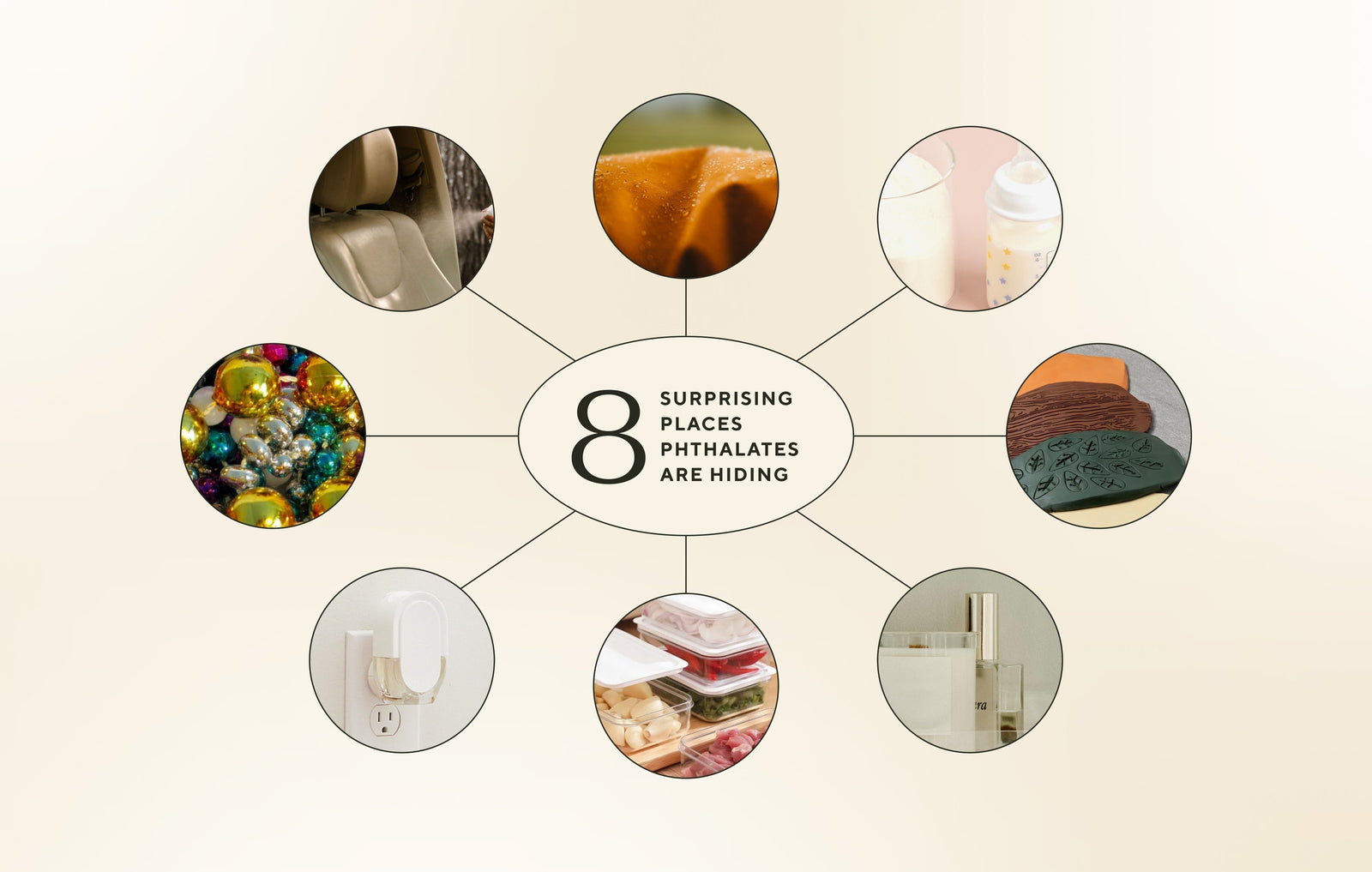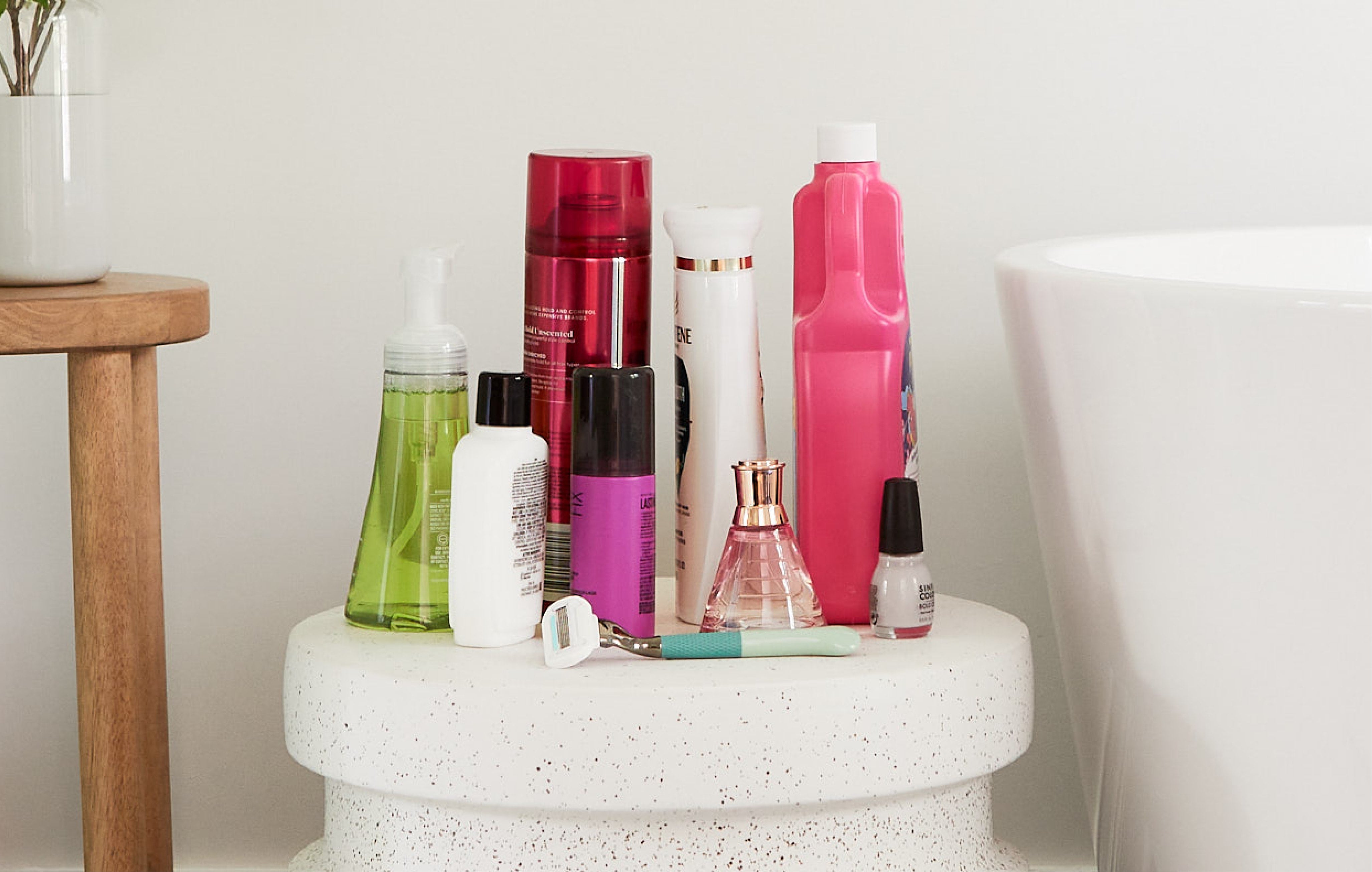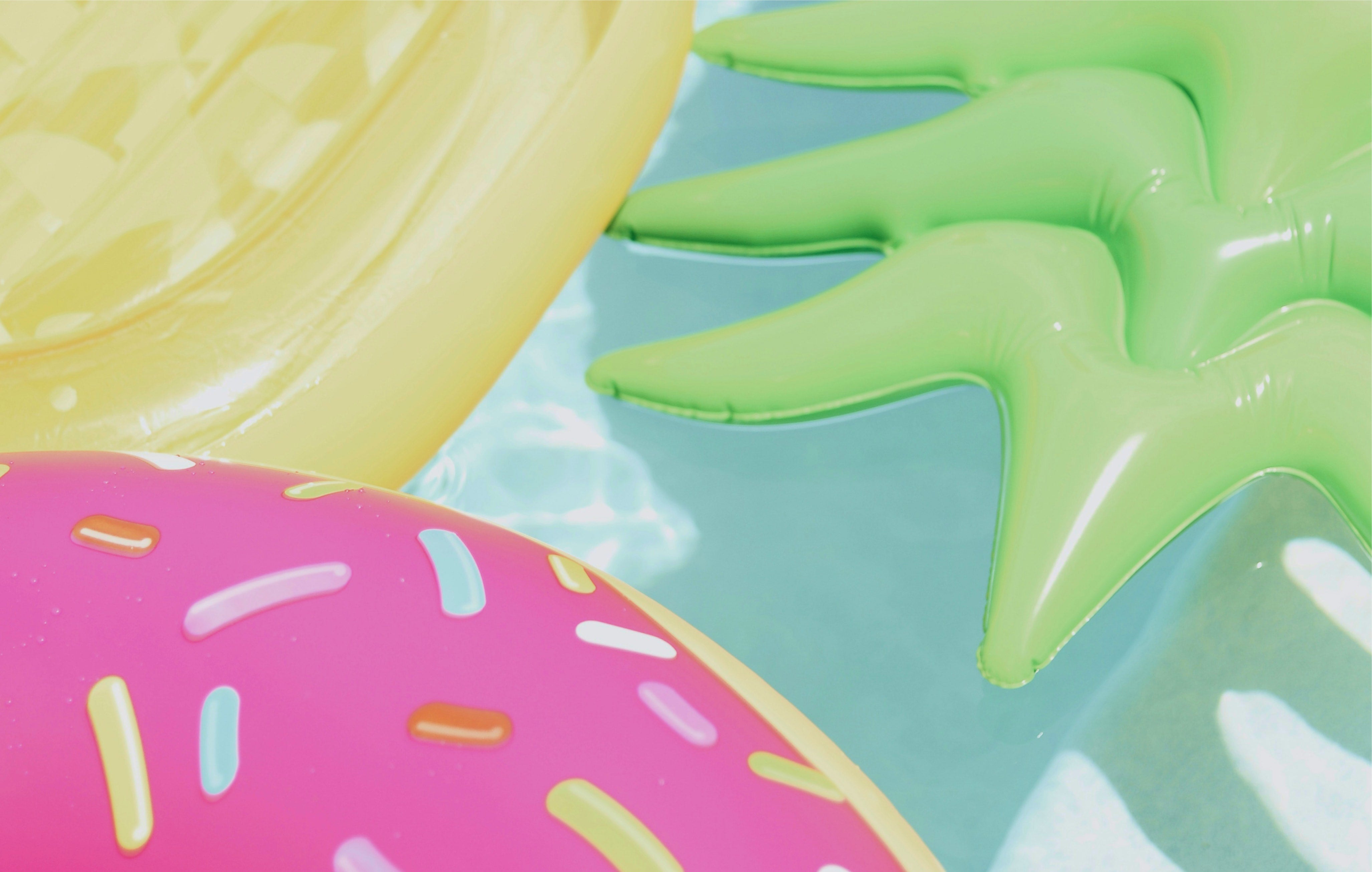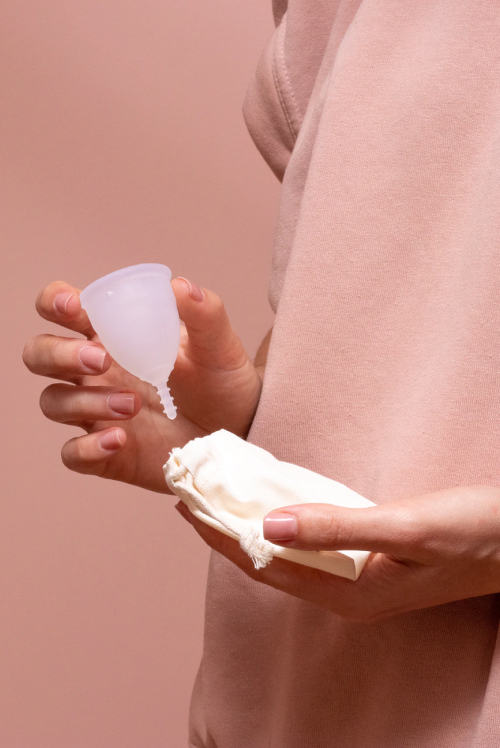Phthalates: Where Are They Hiding & How to Go Phthalate-Free

You've maybe heard about phthalates, or about products being "phthalate-free", but what are they really?
Phthalates, derived from petroleum, are ubiquitous additives in personal care products, serving to soften plastics and polyvinyl chloride (PVC).
However, their presence extends beyond mere functionality, resembling the elusive nature of harmful compounds like Bisphenol A (BPA).
Classified as endocrine disrupting compounds (EDCs),2 phthalates pose a subtle yet significant threat to human health, interfering with hormonal balance and development.
In this article, we explore the covert dangers of phthalates, diving their role in our everyday items and the health risks posed by them.
This is a long one so buckle up and let's get into it!
Health Effects of Phthalates
Phthalates play a big part not only in our lives, but also in animal life around the entire planet.
Products made with phthalates make life easier. Soft plastics are light, easily shaped, strong, easy to ship, and inexpensive. Used in personal care products, phthalates improve texture, increase spreadability, and enhance absorption.
Unfortunately, studies indicate that phthalates interfere with animal and human endocrine systems as they make their way into our bodies from water and food packaged in plastics, personal care products, or by breathing dust containing phthalates.3
Phthalates garnered global attention for their endocrine-disrupting effects, linked to various health concerns such as changes in genital formation, decreased birth rates of boys, early puberty, DNA damage to sperm, decreased sperm counts, birth defects, lowered IQ, behavioral problems, type 2 diabetes, and obesity.
Moreover, their presence in house dust exacerbates rhinitis, eczema, and asthma. Given their ability to cross the placenta, phthalates pose risks to babies during pregnancy and nursing.
Women should pay particularly close attention to their diets and personal care products during pregnancy and nursing to avoid phthalate exposure. Removing products with phthalates, especially those that come into food or water contact, goes a long way in reducing the levels of phthalates in the body.
This is especially important for babies and young children. We will explain the most common sources of phthalates and how to remove or replace. Regular, weekly HEPA vacuuming is another way to reduce your exposure to phthalates, which are present in dust as an SVOC.9
We have provided detailed phthalate sources below, including what to avoid and how to replace them with a safer alternative!
Industry Versus Science
A History of Phthalates
The use of phthalates has skyrocketed since their introduction in the 1920s, when phthalates replaced earlier forms of additives that make plastics more flexible.
The phthalate industry took off in 1931 with the commercial availability of polyvinyl chloride (PVC) and the development of di-2-ethylhexyl phthalate (DEHP). By 1972, one billion pounds of 20 different phthalates were being produced.10
According to estimates by the EPA in 2006, more than 470 million pounds of phthalates are produced each year. Children’s toys and cosmetics have been the focal points in the battle to remove phthalates from consumer products.
As early as 1945, studies showed that DEHP, the most used plasticizer in PVC products, had an adverse effect on rat testicles. However, this warning of the potential reproductive repercussions of phthalates was not taken seriously.
Until the early 1980s, DEHP was used in children’s soft PVC plastic toys and teething rings. Because of the concern that DEHP might be carcinogenic, in 1982, the Toy Manufacturers of America adopted a voluntary standard limiting DEHP in soft PVC teethers and pacifiers to less than 3% in products.12
In December of 1988, DINP (another phthalate used to soften toys) was declared safe by the U.S. Consumer Product Safety Commission, which denied a petition to ban DINP from products intended for children five and under.13
Concern over phthalates in cosmetics rose in 2002, when environmental groups reported that over 70% of personal care products contained phthalates.14
Tests by the Center for Disease Control (CDC) found the highest levels in women of childbearing age. The Cosmetic Ingredient Review (CIR) Expert Panel took this opportunity to assure consumers and reaffirmed its conclusion reached in 1985, that phthalates were safe.15
Despite assurances from the CIR, in June 2006, the city of San Francisco became the first city in the United States to ban the use of bisphenol A and phthalates in products intended for children aged 3 and younger.
In 2008, a monumental breakthrough came when a national coalition won passage of a federal ban on six phthalates in toys as part of the Consumer Safety Protection Improvement Act.17
Sadly, some of the very chemicals that Congress banned from children’s toys were and are still found in children’s school supplies, flooring and wallpaper products. This lack of consistency extended to the FDA’s declaration that “the FDA does not have evidence that phthalates as used in cosmetics pose a safety risk”.19
Phthalate Regulation
What’s the latest on phthalate regulation?
Unfortunately, as of 2018, both the FDA and the American Chemistry Council stand by their statement that “phthalates have been thoroughly studied and reviewed by a number of government scientific agencies and regulatory bodies worldwide and these agencies have concluded that phthalates used in commercial products do not pose a risk to human health.”20
Despite conflicting assurances such as this on the federal level, it is consumer awareness and action that have had the biggest influence on companies voluntarily reducing the use of phthalates in products. As a result, there has been an overall trend towards reduced levels of phthalates in people.
Phthalate Sources in Your Home
Though companies are already beginning to remove phthalates from their products and packaging, you can still take your own precautions to avoid them in your home.
We always recommend paying careful attention to what goes on, in, and around your body, which includes food and food storage, personal care routine, and environmental toxins (the indoor air you breathe).
Below are the facts about specific phthalate sources you might find at home as well as our tips for replacing them.
Food & Water

Food & liquid containers
Plastics (particularly #3 and #7) and non PVC packaging leach phthalates into foods, especially if hot or cold.22 The longer food and water are stored in plastics, the more phthalates will be exposed, especially if distilled or reverse osmosis water is used or if the food or liquid is heated.23
Even flexible cutting boards may contain phthalates and transfer toxins to your food during meal prep.24
Tip: Store and drink water in glass. Use glass, ceramic, porcelain, and stainless-steel containers as much as possible and prepare food using a wooden cutting board. Keep plastic out of the freezer, microwave, and dishwasher.
Even if you purchase something in plastic, you can reduce the amount of phthalates released into it over time by switching it to a different container when you get home. If you must use plastic, opt for plastics with recycling code #1, #2, or #5.
Read Switching to Glass for tips on swapping out plastics for glass in your home and pantry.
Liquid baby formulas & baby food
Phthalates may be in infant formulas and baby food from the packaging and/or from the formula itself.25
Tip: If breastfeeding is not an option, choose powdered formula or use liquid formulas sold in glass containers. For baby food, choose options in glass jars or prepare baby food from fresh ingredients.
Pesticides
Conventional pesticides contain phthalates and diets that include animal foods are especially prone to contain phthalates. Dairy products are a source of significant dietary exposure to phthalates due to plastic containers, milking machines and processing procedures.26
The good news is phthalate levels in your body will reduce quickly if you convert to a fresh foods organic diet (limited packaging) that is high in vegetables.27
Tip: Eat organic foods, particularly if you eat meats and dairy. If you do eat animal products, aim to eat more vegetarian meals each week to reduce phthalate exposure. Phthalate levels tend to be lower among those who follow a vegan diet.28 Consider making your own milk substitutes or, if legal in your state, raw dairy hand-milked from local farms.
Personal Care Products

Cosmetics, personal care products & perfumes
Phthalates are found in synthetic perfumes, scented products, cosmetics, and many other personal care products.29
When you are using cosmetics that contain phthalates, you absorb the toxic material through your skin, which then goes into your bloodstream. There are phthalates in hair spray, nail polish, deodorants, lotions, creams, and powders.
Read Fragrance is the New Secondhand Smoke to find out more about the synthetic chemicals in your fragranced products.
Tip: Switch over to chemical-free, organic skin and body care products. In particular, avoid products with synthetic fragrance, like perfumes and lotions. The EWG database is a valuable resource for researching your personal care products by brand.
Infant care products
The American Academy of Pediatrics states that infants exposed to common products like baby shampoos, baby lotions, and baby powder, showed increased levels of phthalate metabolites in their urine.30
Tip: Look for baby-safe products with ingredients (and packaging) you trust.
Medications & medical devices
Prescription medications and supplements with enteric coating and time-release pharmaceuticals contain phthalates.31
Phthalates also leach out of soft plastic medical devices into stored liquids like blood, plasma, and intravenous fluids.32
Tip: Ask for detailed information about any medication and supplements you are given and request phthalate-free options when possible.
Healthcare without Harm is an initiative focused on avoiding phthalate exposure in the hospital, specifically for infants and children.
Voice your concern about phthalate exposure when you are in the hospital. There are hospitals already making changes towards safer plastics and your voice matters.
Vinyl

Vinyl shower curtains
The familiar “new shower curtain smell” is made up of VOCs from over 100 toxic chemicals, including phthalates. Even after that new smell is gone, the phthalates, which are also a SVOC, keep on outgassing throughout the curtain’s life.33
Tip: Replace vinyl shower curtains with a glass door or natural, untreated fibers like hemp, linen (dries quickly), or cotton (dries slowly, but is washable). Avoid curtains with added biocide or mildewcide protection.
You can also look for nylon or polyester shower curtains, which are quick to dry and are very durable. These are hydrophobic fabrics, which means they repel water.
After initial outgassing, nylon and polyester fabrics will not be a contributor to poor air quality. If you are concerned about mold, choose nylon, which is naturally mold resistant. An even better option? A shower built so that it does not need a door or curtain!
Vinyl flooring
Most vinyl floors contain phthalates, which don’t stay in flooring – they get into the air and ride on the dust we breathe in our homes.34
Tip: Avoid vinyl flooring altogether, particularly if you are building or renovating. If you already have vinyl floors in your home, HEPA vacuum often and cover the flooring with an area rug, sheet, or mat before allowing children to crawl on it.
Vinyl wallpaper
If your wallpaper is vinyl, there is a 34% chance it contains phthalates.35
Tip: If you are able, consider removing or replacing vinyl wallpaper with a nontoxic version. Meanwhile, HEPA vacuum the room often to remove the dust containing phthalates that the wallpaper releases over time.
Vinyl mini blinds
Heat from the sun shining through your windows increases the outgassing of phthalates and other chemicals in vinyl blinds.
Tip: Inexpensive temporary paper shades can be a great way to cover window until safe replacements can be made.
Vinyl diaper changing mats
Soft plastic vinyl diaper changing mats may contain phthalates.36
Tip: Look for non-vinyl, phthalate-free changing mats!
Vinyl rain gear
Studies have found vinyl raincoats are often loaded with toxic chemicals, including phthalates.37
Tip: Look for PVC-free/phthalate-free materials in rain gear, particularly for children.
Vinyl inflatable or blow-up camping & guest mattresses
Inflatable mattresses contain phthalates that continue to outgas as SVOCs, even after the new smell goes away.
Tip: Although PVC-free air mattresses are not an ideal sleeping arrangement, they are a better option than vinyl mattresses. Look for PVC-free /phthalate-free options like the EcoLite or the Kelty Sleep Eazy.
Vinyl school supplies
Regulatory bans on phthalates in toys often don’t apply to school supplies or packaging, and studies and reports have documented high phthalate levels in PVC-based school supplies (e.g. erasers, bags).
As of 2018, there has been no further regulation of chemicals in school supplies, but consumer pressure has impacted the industry.
Tip: Say no to vinyl back packs, plastic notebook binders and lunch boxes. Check out this supply list for safe school supply options.
Vinyl car interiors
Fact: New car smells are due to phthalates from vinyl dashboards and other components, which continue to outgas as an SVOC even after the smell disappears.39
Tip: Air out your car to facilitate outgassing - simply open doors and windows as much as possible when not in use until new smell is gone. Vacuum your car regularly to reduce exposure.
Check out the Green Guard study on phthalates in cars, which demonstrates how Japanese automakers are leading the way to reduce chemical exposure in cars.
Miscellaneous

Air fresheners & plug-ins
Air fresheners and plug-in scented products contain phthalates and have been linked to headaches, endocrine disruption, ear aches, depression, irregular heartbeat, and even diarrhea in babies.40
Tip: Stop using synthetic air fresheners at your home and in your car and request that no air fresheners be used in your workplace.
We created a guide to our favorite Nontoxic Air Fresheners if you need a natural odor remover that won’t make you sick. Don’t forget to opt out of scented options when you go to a carwash or get your car detailed.
We recommend that customers bring Branch Basics All-Purpose and Streak-Free with them to the shop if their car is being detailed.
Electronics
Phthalates are listed as one of the most dangerous chemicals found in electronic equipment.41
Tip: Dust and HEPA vacuum frequently, particularly in rooms that contain significant electronic equipment to reduce exposure. Some electronics manufacturers have committed to phasing out PVC and other toxic chemicals.
You can research companies who are using alternatives through the Greener Electronics Guide by Greenpeace.
“Mardi Gras” plastic beads and other favors
Small plastic trinkets and beaded necklaces, like Mardi Gras Beads and accessories, are made with phthalates and other very toxic chemicals.42
Tip: Despite their kid-friendly appearance, we do not recommend letting children wear or play with these products. Be wary of the manufacturing process and ingredients for plastic trinkets and play necklaces, which may be extremely hazardous to babies and small children in particular.
Toys & crafts
Babies are uniquely vulnerable to phthalate exposures from soft plastic toys given their hand-to-mouth behaviors. Polymer clays, like Fimo and Sculpey, are also often used by children, but release phthalates as well.
Tip: Make sure that toys and other objects, especially those that are meant to be mouthed, are perfectly safe.45
Avoid plastic toys and pacifiers when possible, but when a plastic toy is prefered, choose a phthalate-free plastic toy.
Stay away from #3 plastics and go with #1, #2, or #4. Ideally, replace soft plastic toys with phthalate-free toys made of natural materials like solid wood or cloth (either unfinished or a non-toxic finish).
Creating A Healthy Home
We know this was a lot of information, but just small steps and one healty swap at a time can make a big impact! You cannot go phthalate-free overnight -- these things take time (even years!).
Keep up with Branch Basics on our blog or follow us on Instagram, TikTok and Pinterest. We're always sharing more ways you can create a healthy home.
Categories

Marilee Nelson
Marilee Nelson is an Environmental Toxins expert who has spent nearly 30 years advocating for the chemically-sensitive and chronically-ill. She is a Board Certified Nutritionist, Certified Bau-Biologist and Bau-Biology Inspector and specializes in Food As Medicine. She has helped thousands of families and individuals identify, heal and recover from toxic exposures and is on a mission to revolutionize the way American families view their health.








